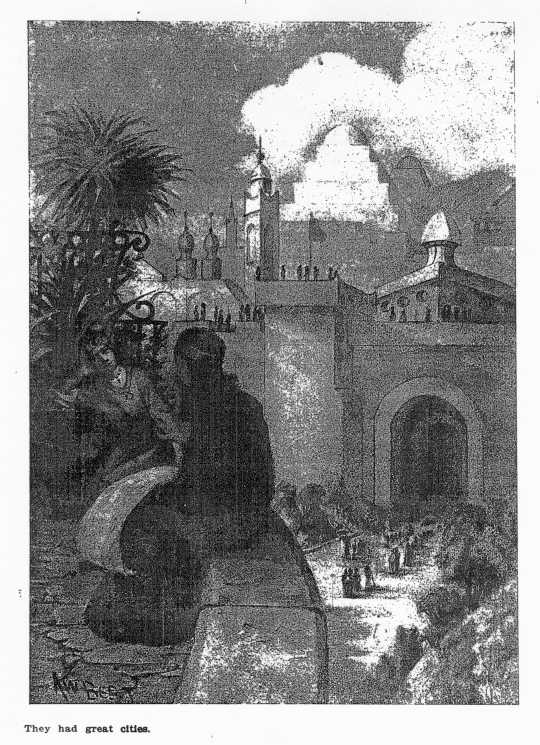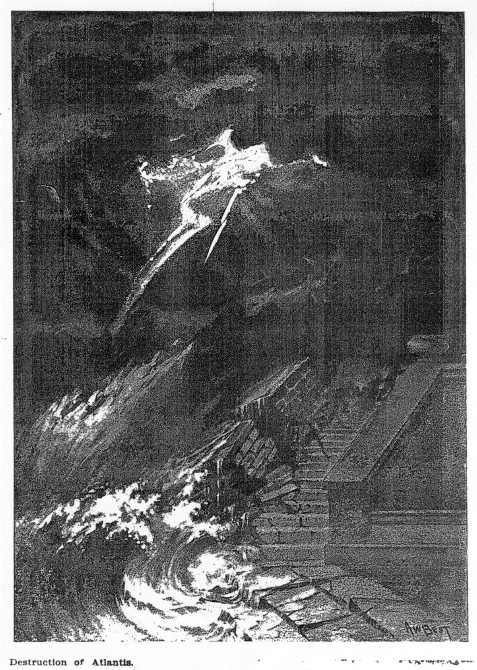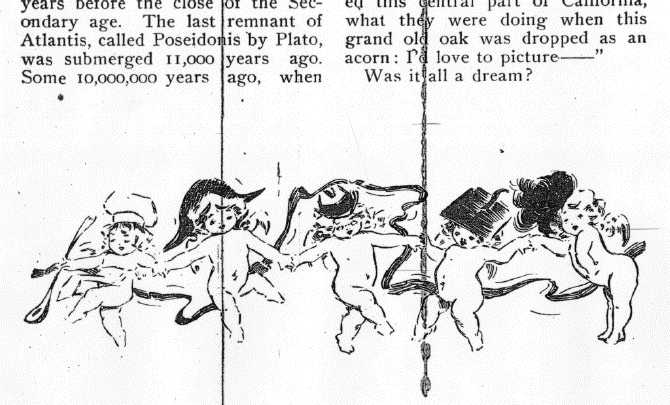| The Man from Atlantis | ||
THE MAN FROM ATLANTIS
BY ALICE H. SILL
HAVING finished reading Irving's "Legend of the Arabian Astrologer," I closed my book, and idly swinging in my hammock, was musing on those beautiful stories of the Alhambra.
My mind was busy rehearsing the story just read. Before me were the two old graybeards quarreling over the rosy-checked princess; I heard the astrologer exclaim "The monarch of a mole-hill to claim sway over him who possesses the talisman of Solomon!" As he smote the earth and sank with the Gothic princess, I felt myself going down—down—when suddenly my descent ceased and my attention became fixed upon a figure which seemed to grow out of the tree, or rather the figure absorbed the whole tree.
Excepting his gigantic stature, he seemed not unlike a man could look, only in place of two eyes he had one in the middle of his forehead.
Observing my fright, for I am the most terrible of cowards, he smiled indulgently; still the one eye gave him such a weird aspect I could hardly keep my teeth from chattering.
After what seemed to me ages, he spoke: "I am one of the Atlanteans, of the Toltec race, which was destroyed 850,000 years ago."
At the word Atlantean, my fear vanished. I would have faced "Old Nick" himself to learn something of that wonderful race, the only ancestors for whom I ever cared a flip.
Noting my interest, he proceeded: "My people were giants, though we were smaller than our ancestors. The first race was 179 feet high; the second, or "sweat-born," measured 120 feet; the third race 60 feet, and the fourth race, from which I came, averaged 27 feet in height.
"We were a very strong people—a bar of iron or steel were no more to us than a small stick to you. In fact, our bodies were so hard that a blow from a bar of iron would bend it, but leave our bodies unhurt. With your knives you could no more cut our flesh than you could cut yonder rock.
"Another advantage we had over you people of to-day was our recuperative powers. Wounds which would kill you we recovered from with rapidity. Our nerves were strong, but not fine, and our taste responded to only the strongest flavors.
"Meat and fish we considered edible only in a putrid state. Do not think from this we were an unclean people, for our higher classes were scrupulously neat, while the lower classes were much as they have been in all ages.
"Asuramaya, one of the greatest astronomers, was a Toltec. He constructed the Zodiac, and handed it down to the Atlanteans of Ruta, and from them it passed to the Egyptians.
"You look with admiration upon Marconi wireless telegraphy and other grand achievements of your day, yet they are as naught to things done in ages past. My people traveled the air in ships, as you now travel the ocean; many thrilling battles took place from these heights; our men, who were the finest chemists, would pour down a flood of poisonous vapors, which

They had great cities.
[Description: Black and white illustration of an exotic city, somewhat middle-eastern in appearance, with several mosque-like towers. Two people sit talking in the foreground, outside the city walls, while groups of people walk into the city gates behind them. Image is signed "AW BEST". ]"Architecture rose to a state of perfection, and some of our cities were models of strength and beauty, as the ruins yet prove to you.
"Gold was much used in building, and many beautiful alloys were used for decorative purposes. Alchemy was a study given much attention.
"During the Toltec civilization, every capital had its central college with affiliated colleges through the province. The lower classes were trained in agriculture, manufacturing and other manual labor. The government looked after their welfare, saw that they had abundant food and plenty of clothing; a governor who neglected these things was removed from office.
"The Toltec sway spread over the land, now beneath the Atlantic, westward over what is now North and South America, and eastward over northern Africa, so that the Egyptians were our friends and neighbors, and may give you a clue to the mystery which has puzzled so many regarding the similarity of many things in common between us."
As the Toltec paused, I asked him the question trembling on my lips since I first saw him: "Why this one eye?"
"Organs of vision were evolved in the third race," he replied. "At first the single eye, or third eye, as it was often called, which was succeeded by the two eyes. This one eye had greater powers of vision than the later two eyes, but disappeared during the reign of the Toltec race."
Again I ventured a question: "I have always thought the Pterodactyl, megalosaurus and those other gigantic animals roamed the earth monarch of all they surveyed. Surely you were worthy to be a contemporary. Pray tell me, was it so?"
"Yes," was the reply. "Man is much older than your scientific men credit him; he came into existence during the Jurassic period of the Mesozoic age, and was the contemporary of those huge animals that roamed the earth, and he had to hold his own among them. Man has existed on this earth at least 40,000,000 years. The earth was far from young when the huge dinosaur stalked the streets of San Francisco, so lately pictured in one of your papers."
Emboldened, I said: "You seem well versed in the antiquity of the world. Have you an idea how old this earth was before man was created?"
"Our wise ones taught us that 300,000,000 years passed away when the Lords came to look if it was habitable for man. At one point gradually the land began to appear. It was the North Pole, and the climate was an exquisite spring. But if 300,000,000 years make you look aghast, what think you of 1,955,884,700 as the life of our solar system?"
"Well," I queried, startled at this stupendous enumeration of aeons of time, "where does the anthropoid ape come in. I suppose he must be more than 50,000,000 years old."
My one-eyed visitor continued:
"This much-discussed ape came into existence in the later third race. The lowest human class at this time, who were called the narrow headed, mated with ape-like animals, not very dissimilar in form from themselves. From this union sprang a race half human and half animal; these again interbred with some of the most degraded Atlanteans; from these descend the anthropoid ape."
"About that femur bone of a

Destruction of Atlantis.
[Description: Black and white illustration of violent storm. Lightning flashes from the sky. Huge waves crumble the stairway to a building. Image is signed "AW BEST". ]Evidently all my questions were not to be answered, for his Toltec Highness said:
"I leave that to your own judgment, and I think your good sense will find the correct answer."
"Do you know how the pyramids were built? As large of stature as you were, I cannot see how you could lift such weights."
"Those stones were not raised by muscle or skillful apparatus; they were raised by those who understood and could control the forces of terrestrial magnetism, so that the stone lost its weight and floated, guided by the touch of a finger."
"When Atlantis was swept away, or rather the Toltec portion of Atlantis, was that the first cataclysm the world ever knew?"
"No; Lemuria superceded Atlantis, and was destroyed by earthquakes and volcanoes some 700,000 years before the close of the Secondary age. The last remnant of Atlantis, called Poseidonis by Plato, was submerged 11,000 years ago."
"Some 10,000,000 years ago, when the world was in the Triassic period, of which so many fossils are found around Berkeley, I presume your race had about reached the zenith of her glory?"
"We cannot claim such antiquity. In the early age of the earth, convulsions and the breaking asunder of the ocean floors was happening very frequently. As I just told you, Lemuria was destroyed 700,000 years before the close of the Secondary age, having reached a high state of civilization. Atlantis followed next, and during the Eocene age she reached her highest spirituality; main part of Atlantis was destroyed by a great cataclysm about the middle of the Miocene age, some 4,000,000 years ago. Then came the Toltecs, which were destroyed 850,000 years ago during the Pliocene age. After the destruction of the fourth race, of which a chosen few escaped, the fifth race, the Aryans, were established in Central Asia, about 1,000,000 years ago, and with their history you doubtless are already familiar."
"I have always longed to know what race of the old timers inhabited this central part of California, what they were doing when this grand old oak was dropped as an acorn; I'd love to picture—"
Was it all a dream?
| The Man from Atlantis | ||
